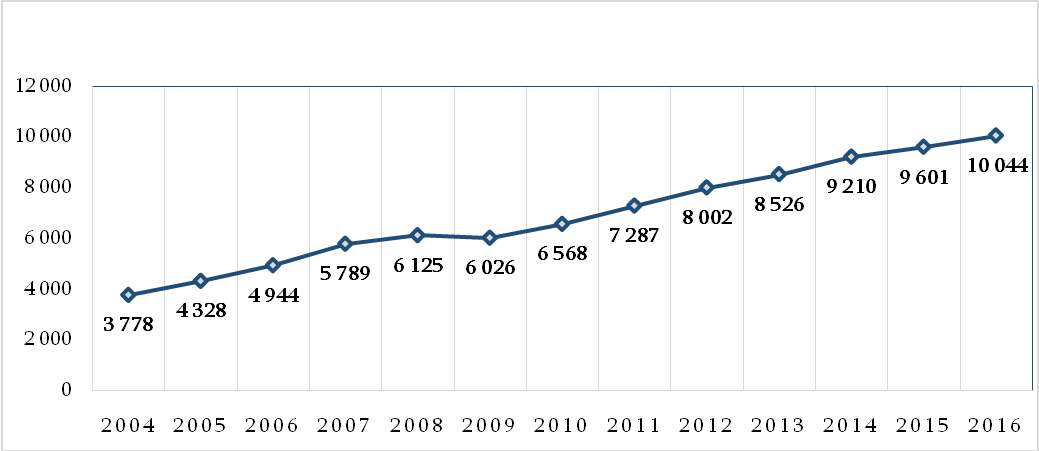The Speaker of the Parliament of Georgia, Irakli Kobakhidze, stated: “Since 2004 up until 2012, we have been outsiders in the region in terms of economic growth. Before the 2008 war, we were only ahead of Moldova and after the war we were only ahead of Ukraine. After 2012, Georgia became one of the leaders in terms of economic growth rates. For the first time, we achieved a GDP per capita exceeding USD 10,000. In 2013-2015, during these three years, more than 90,000 individuals were hired for jobs whilst this figure was only 45,000 during the previous nine years. This means that twice as many people were hired in these three years than in the previous nine years combined.”
FactCheck verified the accuracy of the statement.
The International Monetary Fund (IMF) publishes the economic growth figures of different countries. The IMF categorises Georgia as a part of the Commonwealth of Independent States (CIS) group. Georgia ended its membership of the CIS in 2009 and officially declared its Euro-Atlantic aspirations and so we believe it is appropriate to consider Eastern European countries as well as CIS member states when speaking about Georgia’s region.
According to IMF data for the given timespan and considering the 24 countries of the region, Georgia has been classified as an outsider[1] in 2004, 2008 and 2009 under the previous government in the 17th, 20th and 15th places, respectively, whilst under the Georgian Dream government, it has been pooled among the outsiders in 2015 and 2016 in the 15th and 14th places, also respectively. Of note is that economic growth figures in 2008 and 2009 were largely affected by the war in the country as well as negative external factors. In regard to other years, Georgia has been in the 5th place in 2005 and 2012, in the 6th place in 2006 and 2011 and in the 8th place in 2010 among the countries of the region. In 2007, it managed to reach the 3rd position which was the country’s best performance. In 2013, Georgia was on the brink of being an outsider with its 3.4% economic growth rate (12th place). The country moved to the 6th place in 2014.
Irakli Kobakhidze’s statement seemingly implies that in the years 2004-2007 and 2009-2012, Georgia was ahead of only one country (Moldova or Ukraine) in the region in terms of economic growth rates. In 2004-2007, only Azerbaijan was distinguished with a remarkably high economic growth each year as compared to Georgia. In the given timespan, there has been at least one year when Georgia’s economic growth rate was higher as compared to the economic growth rates of the remaining 22 countries of the regional group. In 2009-2012, Georgia did not exhibit a constant lag behind any particular country. In 2013-2016, it was among the top ten countries only once when it moved to the 6th place in 2014.
Graph 1: Economic Growth Rate Dynamic in Georgia, 2004-2016
 Source: International Monetary Fund
In his statement, Irakli Kobakhidze refers to the GDP vis-à-vis the Purchasing Power Parity (PPP) indicator when making his claim that Georgia’s GDP per capita exceeds USD 10,000. This method of GDP calculation indicates that the purchasing power of income is higher in low income countries, owing to the lower prices of products, as compared to the same amount of income in wealthier countries. In 2011, for instance, an individual in Georgia needed USD 3,231 and an individual in the USA needed USD 7,287 to purchase the same amount of products. Therefore, each USD spent in Georgia had 2.25 (7,287 divided by 3,231) times more purchasing power as compared to the USD spent in the USA.
The volume of GDP (PPP) did increase in the period of 2004-2012. The only exception was 2009 when the GDP (PPP) dropped as compared to the previous year. The highest figure of Georgia’s GDP (USD 10,044) calculated by this method was registered in 2016. However, the figure was also positively affected by the results of the universal public census which showed that Georgia’s population was 700,000 less than calculated in official statistical data. Decreased population numbers resulted in increased income figures per capita.
Additionally, if we want to understand how the per capita income has been changing in Georgia, we have to use the per capita income in real (minus the inflation) GEL (because GEL is the principal payment currency in Georgia) and not in international USD. Income in international USD might fluctuate depending on the changing level of prices in Georgia and the USA (GEL-USD exchange rate, etc.). It does not depend on the country’s economic growth alone. FactCheck has written about this topic before.
Graph 2: Georgia’s GDP (PPP) in 2004-2016
Source: International Monetary Fund
In his statement, Irakli Kobakhidze refers to the GDP vis-à-vis the Purchasing Power Parity (PPP) indicator when making his claim that Georgia’s GDP per capita exceeds USD 10,000. This method of GDP calculation indicates that the purchasing power of income is higher in low income countries, owing to the lower prices of products, as compared to the same amount of income in wealthier countries. In 2011, for instance, an individual in Georgia needed USD 3,231 and an individual in the USA needed USD 7,287 to purchase the same amount of products. Therefore, each USD spent in Georgia had 2.25 (7,287 divided by 3,231) times more purchasing power as compared to the USD spent in the USA.
The volume of GDP (PPP) did increase in the period of 2004-2012. The only exception was 2009 when the GDP (PPP) dropped as compared to the previous year. The highest figure of Georgia’s GDP (USD 10,044) calculated by this method was registered in 2016. However, the figure was also positively affected by the results of the universal public census which showed that Georgia’s population was 700,000 less than calculated in official statistical data. Decreased population numbers resulted in increased income figures per capita.
Additionally, if we want to understand how the per capita income has been changing in Georgia, we have to use the per capita income in real (minus the inflation) GEL (because GEL is the principal payment currency in Georgia) and not in international USD. Income in international USD might fluctuate depending on the changing level of prices in Georgia and the USA (GEL-USD exchange rate, etc.). It does not depend on the country’s economic growth alone. FactCheck has written about this topic before.
Graph 2: Georgia’s GDP (PPP) in 2004-2016
 Source: International Monetary Fund
In his statement, Irakli Kobakhidze mentioned employment figures in the country. In 2004-2012, the number of hired persons increased by 44,000 and by 91,000 in 2013-2015. Even though the numbers in Mr Kobakhidze’s statement are correct, we have to consider the sectors of the economy where these jobs were created; that is, in the state sector or the non-state sector.
The National Statistics Office of Georgia has been publishing information about the country’s sectoral distribution of employment since 2006. According to this information, the number of individuals employed in the state sector decreased by 86,600 from 2006 to 2013 whilst number of employees in the non-state sector increased by 63,400. In 2013-2015, jobs in the state sector increased by 1,200 and by 54,700 in the private sector. In 2010-2012, employment in the state sector decreased by 24,700 whilst employment in the non-state sector increased by 92,500. Therefore, if we compare the three-year period of the Georgian Dream to the last three years (2010-2012) of the previous government, it is evident that jobs in the non-state sector (which mostly comprises the private sector) were created in larger numbers under the previous government.
Table 1: Distribution of Employees Based on Institutional Sectors (thousand persons)
Source: International Monetary Fund
In his statement, Irakli Kobakhidze mentioned employment figures in the country. In 2004-2012, the number of hired persons increased by 44,000 and by 91,000 in 2013-2015. Even though the numbers in Mr Kobakhidze’s statement are correct, we have to consider the sectors of the economy where these jobs were created; that is, in the state sector or the non-state sector.
The National Statistics Office of Georgia has been publishing information about the country’s sectoral distribution of employment since 2006. According to this information, the number of individuals employed in the state sector decreased by 86,600 from 2006 to 2013 whilst number of employees in the non-state sector increased by 63,400. In 2013-2015, jobs in the state sector increased by 1,200 and by 54,700 in the private sector. In 2010-2012, employment in the state sector decreased by 24,700 whilst employment in the non-state sector increased by 92,500. Therefore, if we compare the three-year period of the Georgian Dream to the last three years (2010-2012) of the previous government, it is evident that jobs in the non-state sector (which mostly comprises the private sector) were created in larger numbers under the previous government.
Table 1: Distribution of Employees Based on Institutional Sectors (thousand persons)
Source: National Statistics Office of Georgia
Conclusion
Irakli Kobakhidze makes incorrect conclusions about Georgia’s economic growth. In the period of 2004-2012 and considering the 24 countries of the region, Georgia was among the outsiders only in 2004, 2008 and 2009. The economic growth figures of 2008 and 2009 were affected by the Russia-Georgia war and the global recession. In 2013-2016, however, the country was ranked as an outsider two times whilst once appearing on the brink. Moreover, based on the International Monetary Fund’s data, Georgia did not fall behind any of the countries of the regional grouping during all nine years of the United National Movement’s rule. Therefore, Mr Kobakhidze’s claim that we were only ahead of Moldova before the war and ahead of Ukraine after the war is not true.
Georgia’s GDP (PPP) per capita grew in 2004-2016 (2009 being the only exception) and reached USD 10,044 in 2016. However, it was partiallly affected by the decline in Georgia’s population. Furthermore, the most appropriate method for observing trends of income growth is to study the income per capita in real GEL.
In regard to people who were hired for jobs, Irakli Kobakhidze does provide correct figures. However, we should consider that employment in the state sector decreased under the previous government whilst employment in the non-state sector grew more rapidly as compared to 2013-2015.
FactCheck concludes that Irakli Kobakhidze’s statement is MOSTLY FALSE.
[1] Thirteenth (13th) or lower position among the countries of the region.
 Source: International Monetary Fund
In his statement, Irakli Kobakhidze refers to the GDP vis-à-vis the Purchasing Power Parity (PPP) indicator when making his claim that Georgia’s GDP per capita exceeds USD 10,000. This method of GDP calculation indicates that the purchasing power of income is higher in low income countries, owing to the lower prices of products, as compared to the same amount of income in wealthier countries. In 2011, for instance, an individual in Georgia needed USD 3,231 and an individual in the USA needed USD 7,287 to purchase the same amount of products. Therefore, each USD spent in Georgia had 2.25 (7,287 divided by 3,231) times more purchasing power as compared to the USD spent in the USA.
The volume of GDP (PPP) did increase in the period of 2004-2012. The only exception was 2009 when the GDP (PPP) dropped as compared to the previous year. The highest figure of Georgia’s GDP (USD 10,044) calculated by this method was registered in 2016. However, the figure was also positively affected by the results of the universal public census which showed that Georgia’s population was 700,000 less than calculated in official statistical data. Decreased population numbers resulted in increased income figures per capita.
Additionally, if we want to understand how the per capita income has been changing in Georgia, we have to use the per capita income in real (minus the inflation) GEL (because GEL is the principal payment currency in Georgia) and not in international USD. Income in international USD might fluctuate depending on the changing level of prices in Georgia and the USA (GEL-USD exchange rate, etc.). It does not depend on the country’s economic growth alone. FactCheck has written about this topic before.
Graph 2: Georgia’s GDP (PPP) in 2004-2016
Source: International Monetary Fund
In his statement, Irakli Kobakhidze refers to the GDP vis-à-vis the Purchasing Power Parity (PPP) indicator when making his claim that Georgia’s GDP per capita exceeds USD 10,000. This method of GDP calculation indicates that the purchasing power of income is higher in low income countries, owing to the lower prices of products, as compared to the same amount of income in wealthier countries. In 2011, for instance, an individual in Georgia needed USD 3,231 and an individual in the USA needed USD 7,287 to purchase the same amount of products. Therefore, each USD spent in Georgia had 2.25 (7,287 divided by 3,231) times more purchasing power as compared to the USD spent in the USA.
The volume of GDP (PPP) did increase in the period of 2004-2012. The only exception was 2009 when the GDP (PPP) dropped as compared to the previous year. The highest figure of Georgia’s GDP (USD 10,044) calculated by this method was registered in 2016. However, the figure was also positively affected by the results of the universal public census which showed that Georgia’s population was 700,000 less than calculated in official statistical data. Decreased population numbers resulted in increased income figures per capita.
Additionally, if we want to understand how the per capita income has been changing in Georgia, we have to use the per capita income in real (minus the inflation) GEL (because GEL is the principal payment currency in Georgia) and not in international USD. Income in international USD might fluctuate depending on the changing level of prices in Georgia and the USA (GEL-USD exchange rate, etc.). It does not depend on the country’s economic growth alone. FactCheck has written about this topic before.
Graph 2: Georgia’s GDP (PPP) in 2004-2016
 Source: International Monetary Fund
In his statement, Irakli Kobakhidze mentioned employment figures in the country. In 2004-2012, the number of hired persons increased by 44,000 and by 91,000 in 2013-2015. Even though the numbers in Mr Kobakhidze’s statement are correct, we have to consider the sectors of the economy where these jobs were created; that is, in the state sector or the non-state sector.
The National Statistics Office of Georgia has been publishing information about the country’s sectoral distribution of employment since 2006. According to this information, the number of individuals employed in the state sector decreased by 86,600 from 2006 to 2013 whilst number of employees in the non-state sector increased by 63,400. In 2013-2015, jobs in the state sector increased by 1,200 and by 54,700 in the private sector. In 2010-2012, employment in the state sector decreased by 24,700 whilst employment in the non-state sector increased by 92,500. Therefore, if we compare the three-year period of the Georgian Dream to the last three years (2010-2012) of the previous government, it is evident that jobs in the non-state sector (which mostly comprises the private sector) were created in larger numbers under the previous government.
Table 1: Distribution of Employees Based on Institutional Sectors (thousand persons)
Source: International Monetary Fund
In his statement, Irakli Kobakhidze mentioned employment figures in the country. In 2004-2012, the number of hired persons increased by 44,000 and by 91,000 in 2013-2015. Even though the numbers in Mr Kobakhidze’s statement are correct, we have to consider the sectors of the economy where these jobs were created; that is, in the state sector or the non-state sector.
The National Statistics Office of Georgia has been publishing information about the country’s sectoral distribution of employment since 2006. According to this information, the number of individuals employed in the state sector decreased by 86,600 from 2006 to 2013 whilst number of employees in the non-state sector increased by 63,400. In 2013-2015, jobs in the state sector increased by 1,200 and by 54,700 in the private sector. In 2010-2012, employment in the state sector decreased by 24,700 whilst employment in the non-state sector increased by 92,500. Therefore, if we compare the three-year period of the Georgian Dream to the last three years (2010-2012) of the previous government, it is evident that jobs in the non-state sector (which mostly comprises the private sector) were created in larger numbers under the previous government.
Table 1: Distribution of Employees Based on Institutional Sectors (thousand persons)
| 2006 | 2007 | 2008 | 2009 | 2010 | 2011 | 2012 | 2013 | 2014 | 2015 | |
| In Total | 1,747 | 1,704 | 1,602 | 1,656 | 1,628 | 1,664 | 1,724 | 1,712 | 1,745 | 1,780 |
| State Sector | 360 | 327 | 275 | 298 | 286 | 266 | 274 | 247 | 251 | 275 |
| Non-state sector | 1,387 | 1,377 | 1,327 | 1,358 | 1,342 | 1,398 | 1,450 | 1,465 | 1,494 | 1,505 |
Tags:








